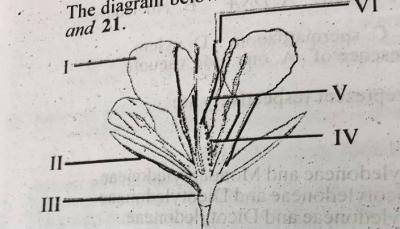Year :
2019
Title :
Biology
Exam :
WASSCE/WAEC MAY/JUNE
Paper 1 | Objectives
11 - 20 of 50 Questions
| # | Question | Ans |
|---|---|---|
| 11. |
The heart can beat continuously without being fatigued because it is composed of________ A. skeletal muscles B. smooth muscles C. cardiac muscles D. renal muscles |
C |
| 12. |
The products of tissue respiration are_________ A. glucose, oxygen, and water B. oxygen, water, and energy C. glucose, carbon dioxide, and energy D. water, carbon dioxide, and energy |
D |
| 13. |
Excretory products in plants responsible for the discoloration of flowers are called__________ A. alkaloids B. tannins C. anthocyanins D. resins |
D |
| 14. |
The process of maintaining a steady internal environment is known as__________ A. osmoregulation B. equilibration C. homeostasis D. plasmolysis |
C |
| 15. |
Which of the following statements is not true about hormones? A. Their responses are voluntary B. They may affect more than one target organ C. They are chemical messengers in animals D. They are transported by the blood to the target organs |
B |
| 16. |
 The diagram above is an illustration of a human brain. Study it and answer this question A. olfactory lobe B. cerebellum C. cerebrum D. medülla oblongata |
C |
| 17. |
 The function of the part labelled II is that it controls_______ A. posture and balance of the body B. all voluntary actions C. temperature and appetite D. many involuntary actions |
D |
| 18. |
To focus on a distant object, the ciliary muscle of the eye______ A. contracts and the eye lens gets thicker B. relaxes and the eye lens gets thinner C. contracts and the eye lens gets thinner D. relaxes and the eye lens gets thicker |
D |
| 19. |
The main function of the amniotic fluid is for______________ A. respiration in the foetus B. protection of the foetus from shock C. Lubricating the birth canal foetus D. nourishing the foetus |
B |
| 20. |
 The diagram above is an illustration of the longitudinal section of a flower. Study it and answer this question A. I B. II C. III D. IV |
B |
| 11. |
The heart can beat continuously without being fatigued because it is composed of________ A. skeletal muscles B. smooth muscles C. cardiac muscles D. renal muscles |
C |
| 12. |
The products of tissue respiration are_________ A. glucose, oxygen, and water B. oxygen, water, and energy C. glucose, carbon dioxide, and energy D. water, carbon dioxide, and energy |
D |
| 13. |
Excretory products in plants responsible for the discoloration of flowers are called__________ A. alkaloids B. tannins C. anthocyanins D. resins |
D |
| 14. |
The process of maintaining a steady internal environment is known as__________ A. osmoregulation B. equilibration C. homeostasis D. plasmolysis |
C |
| 15. |
Which of the following statements is not true about hormones? A. Their responses are voluntary B. They may affect more than one target organ C. They are chemical messengers in animals D. They are transported by the blood to the target organs |
B |
| 16. |
 The diagram above is an illustration of a human brain. Study it and answer this question A. olfactory lobe B. cerebellum C. cerebrum D. medülla oblongata |
C |
| 17. |
 The function of the part labelled II is that it controls_______ A. posture and balance of the body B. all voluntary actions C. temperature and appetite D. many involuntary actions |
D |
| 18. |
To focus on a distant object, the ciliary muscle of the eye______ A. contracts and the eye lens gets thicker B. relaxes and the eye lens gets thinner C. contracts and the eye lens gets thinner D. relaxes and the eye lens gets thicker |
D |
| 19. |
The main function of the amniotic fluid is for______________ A. respiration in the foetus B. protection of the foetus from shock C. Lubricating the birth canal foetus D. nourishing the foetus |
B |
| 20. |
 The diagram above is an illustration of the longitudinal section of a flower. Study it and answer this question A. I B. II C. III D. IV |
B |